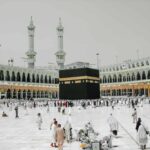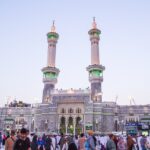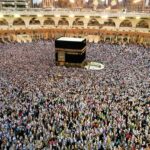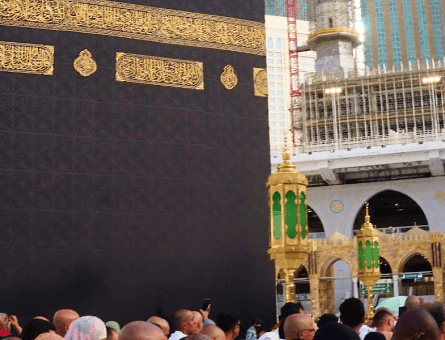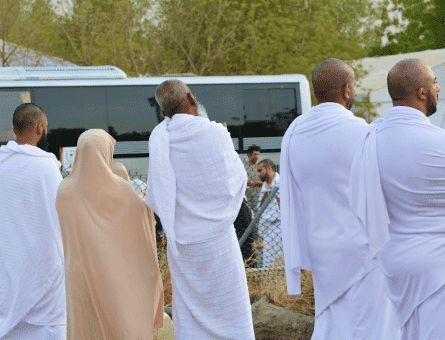Praying in Hijr Ismail – Everything you need to know
Otherwise known as Hateem, Hijr Ismail is a three-metre, semi-circular marble wall constructed next to one of the sides of the Sacred Kaaba, but not connected to it.
Even though it is situated outside the boundaries of the Sacred Kaaba, Hijr Ismail is considered a part of the House of Allah SWT. Keep reading to learn the significance of praying in Hijr Ismail
What Is Hijr Ismail?
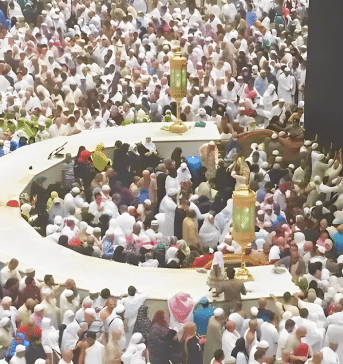
‘Hijr’ is an Arabic word that literally means ‘Home.’ Hijr Ismail was given its name after Prophet Ismail (AS) constructed a shelter (home) for his infant son and wife, Prophet Ismail (AS) and Hajar (RA). Another name for Hijr Ismail is ‘Hateem’ meaning ‘Stone of Ismail.’ While many people refer to it as the ‘Ruins,’ Prophet Muhammad (PBUH) called it the ‘Wall’ or ‘Barrier.’
Hijr Ismail is situated in the northwestern part of the Holy Kaaba. It is a semi-circular area marked by a low 4-foot 4-inch tall and 2-foot 11-inches wide wall outside the sacred House of Allah SWT. Even though Hijr Ismail isn’t directly connected to the Sacred Kabah, this three-metre-wide crescent-shaped area is considered a part of the Sacred Kaaba.
Aisha (RA) narrated that Prophet Muhammad (PBUH) said, “Pray in Hijr Ismail or Hateem when you intend to enter the Sacred Kaaba, for it is a part of the Kaaba.” (Sunan Abi Dawood, 2028) This is precisely why (Hajj and Umrah) pilgrims during Tawaf aren’t allowed to walk inside the area of Hateem.
Importance of Hateem in Kaaba
Aisha (RA) narrated, “I wanted to enter the House (the Sacred Kabah) and pray inside it, but the Messenger (PBUH) of Allah SWT took me by the hand and led me into al-Hijr and said: “Pray in al-Hijr if you want to enter the House, for it is a part of the House, but your people ran out of funds when they (re) built the Sacred Kaaba, so they left it outside the House.” (Abu Dawud (2028), al-Tirmidhi (876) and al-Nasaa’i (2912))
This means that praying in Hijr Ismail or Hateem is equivalent to praying inside the Holy Kaaba which is a once-in-a-lifetime opportunity and holds great rewards for the believers. The area of Hateem is usually crowded, especially because every Muslim wishes to offer two Rakat of Nafl there.
However, it is empty when the Imam of Masjid Al-Haram leads the congregational prayers.
According to Islamic scriptures, the Messenger (PBUH) of Allah SWT used to spend hours in Hateem reciting the Holy Quran and worshipping Allah SWT. Jabar Bin Abdullah (RA) narrated that Prophet Muhammad (PBUH) said, “When the people of Quraysh did not believe me (i.e. the story of my Night Journey), I stood upon the Hijr Ismail or Hateem and Allah displayed Jerusalem in front of me, and I began describing it to them while I was looking at it.” (Sahih al-Bukhari 3886)
Not only this but even before prophethood, Hateem held great importance in the eyes of the people. It was believed to be a sacred place where Abdul Muttalib, the grandfather of Prophet Muhammad (PBUH) used to spend hours sitting in solitude.
According to narrations, one night while sleeping in Hateem, Abdul Muttalib dreamt of a shadowy figure that directed him to the hidden well of Zamzam.
Can You Pray in the Hateem?
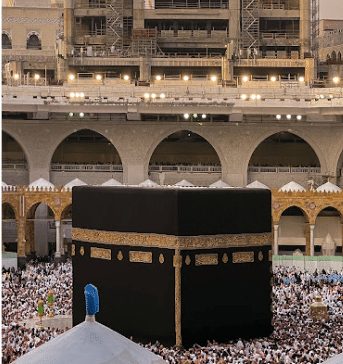 The simple answer to this question is “Yes;” pilgrims are allowed to pray in the Hateem. In light of the significance of praying inside Hateem, Aisha (RA) narrated, “When I expressed the wish to perform salah within the Kabah, the Prophet (PBUH) took me by the hand and led me into the Hijr (Hateem) where he (PBUH) said, ‘Perform salah here if you wish to enter the Kaaba because this is part of the Baitullah.'” (Abu Dawud)
The simple answer to this question is “Yes;” pilgrims are allowed to pray in the Hateem. In light of the significance of praying inside Hateem, Aisha (RA) narrated, “When I expressed the wish to perform salah within the Kabah, the Prophet (PBUH) took me by the hand and led me into the Hijr (Hateem) where he (PBUH) said, ‘Perform salah here if you wish to enter the Kaaba because this is part of the Baitullah.'” (Abu Dawud)
Ibn Qudamah (may Allah have mercy on him) said, “Obligatory (fard) prayers are not valid inside the Ka‘bah or on its roof, but they were regarded as permissible by al-Shaafa‘i and Abu Haneefah, because it is a mosque and because it is a place for naafil praying, so it should be a place for obligatory prayers too, just like the area outside it. But Allah says (interpretation of the meaning): ‘And from wheresoever, you start forth (for prayers), turn your face in the direction of Al-Masjid Al-Haraam (at Makkah).'” [2:149]
The worshipper who is inside it or on its roof is not facing it. But the basic principle with regard to nafl prayers is that the rulings on them are less stringent, based on the fact that they may be prayed whilst seated, facing a direction other than the qiblah, and, when travelling, on one’s mount. Then he said: Nafl prayers are valid if offered inside the Kaaba or on its roof, and we do not know of any difference of opinion concerning that, because the Prophet (PBUH) prayed two rakahs inside the Kaaba. (al-Mughni, 1/406)
Hijr Ismail history
It is reported, when Prophet Ibrahim (AS) arrived in the city of Makkah, Saudi Arabia with his wife Hajar (RA) and son, Prophet Ismail (AS), the archangel Jibreel (AS) guided them to the area of Hateem.
Prophet Ibrahim (AS) then used branches of trees to construct a shade for his beloved wife and child. He then left them under the protection of Allah SWT. Hijr Ismail is also called ‘Bayt Ismail,’ meaning the ‘House of Ismail.’
It is also believed that Hajar (RA) passed away while residing in Hateem and was buried here. Prophet Ismail (AS) later constructed a fence around his mother’s grave to prevent people from stepping over it. However, according to different narrations, the grave of Prophet Ismail (AS) is also situated in Hateem (Hijr Ismail).
Little do people know that the tale of the construction of Hijr Ismail doesn’t end here. When Prophet Muhammad (PBUH) was 35 years old, the Sacred Kaaba underwent devastating damage due to a flood after which it was decided by the superior authorities of Makkah to reconstruct the House of Allah SWT.
However, during the rebuilding process, the Quraysh faced a lack of funds and resources because of which they weren’t able to connect Hijr Ismail with the Sacred Kaaba. Instead, they decided to construct a small wall around the foundation of Hateem which was laid by Prophet Ibrahim (AS), on the northwestern side of the Sacred Kaaba.
The Messenger (PBUH) of Allah SWT said, “O Aisha! Had your people not very recently been in the Period of Ignorance, I would have had the Kaabah demolished and included the left-out portion within its walls. I would have also brought the inside of the Kaabah to ground level and added two doors, with one on the eastern wall and the other on the western wall. In this manner, it would be according to the building and foundation of Ibrahim (AS).” (Bukhari)
Later in 65 AH, Abdullah bin Zubair (RA) had the Sacred Kaaba reconstructed according to the wish of Prophet Muhammad (PBUH).
“The Prophet Muhammad (PBUH) was asked by Aisha (RA) about the reason behind Hijr Ismail not being connected to the walls of the Kaaba, to which he (SAW) replied, “Because your people (the Quraysh) did not have sufficient funds.” [Bukhari]”
Why Is It Called Hijr Ismail?
According to Islamic history, the crescent shape of Hijr Ismail represents the area where Prophet Ibrahim (AS) constructed a shelter for his firstborn, Prophet Ismail (AS), and his wife, Hajar (RA).
Photos of the Hijr Ismail
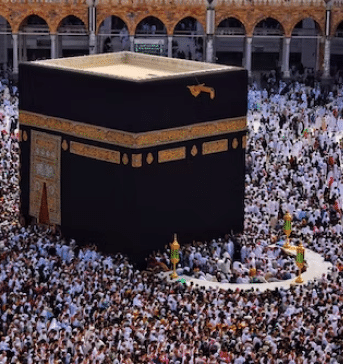
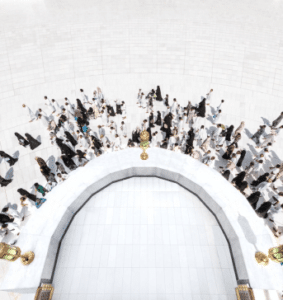
Who Is Buried in Hateem?
During the reconstruction of the Holy Kabah, the area of Hijr Ismail (Hateem) was left outside. This was because it is believed that underneath the foundation of Hateem are the graves of Prophet Ismail (AS) and his mother, Hajar (RA).
However, there are scholars who have rejected these narrations and claimed them to be Da’eef (weak).
Can Muslims Pray Inside the Kaaba?
When asked about praying inside the Kaaba, Shaykh ibn Baaz (may Allah have mercy on him) said: “Praying inside Hijr Ismail (Hateem) is mustahabb, because it is part of the Kaaba, and it is narrated in a sahih hadith from the Prophet Muhammad (PBUH) that he entered the Kaaba during the year of the conquest (of Makkah) and prayed two Rakats inside it.”
In another instance, it is reported that when the beloved wife of Prophet Muhammad (PBUH), Aisha (RA) expressed a desire to pray inside the Holy Kaaba, the Messenger (PBUH) of Allah SWT replied, “Pray in Al-Hijr, for this is a part of the House (Sacred Kabah).”
However, one should be cautious when it comes to performing obligatory prayers inside the Holy Kaaba or Hateem (Hijr Ismail) as Prophet Muhammad (PBUH) didn’t do that.
Therefore, Islamic scholars have advised Muslims that it isn’t valid to pray obligatory prayers in Hateem or inside the Sacred Kaaba.
Thus, following the example of Prophet Muhammad (PBUH), it is recommended that one performs obligatory prayers outside the Sacred Kaaba and outside Hijr Ismail (Hateem).
Summary – Praying in Hijr Ismail
Hijr Ismail, also known as Hateem, literally means the ‘Stone of Ismail.’ It is a three-metre crescent-shaped area situated adjacent to the Holy Kabah.
The sacred area of Hateem holds great importance in Islam as the reward of praying inside Hijr Ismail is considered equivalent to praying inside the Sacred Kabah.
Explore The New Pilgrim App
The Ultimate App
for Hajj and Umrah!




